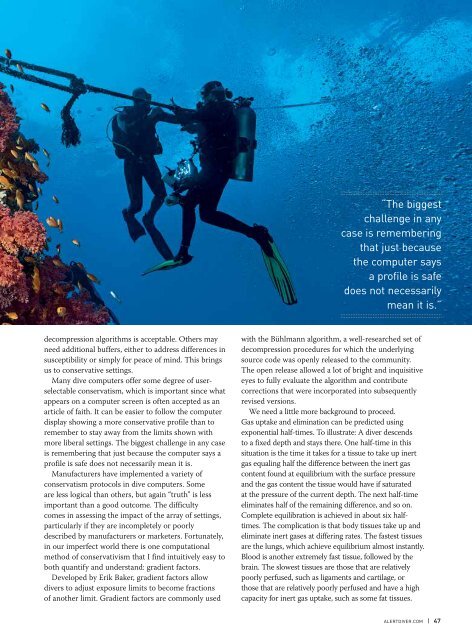AD 2015 Q4
This is the “not do” component. It is also somewhat harder to define. After all, who determines the duty to care and the non-compliance thereto in unique emergency situations? Still, this component is more likely to lead to a recovery of damages. Put differently, when you are under a legal duty to take reasonable care and you do not do it, then you could be held liable for damages that are directly caused by the breach of that duty. The key elements are “reasonable care” and “directly caused”. Let’s break that down, starting with directly caused. This means that the damages are linked directly to the failure to perform the reasonable duty. This is called a causal connection. In other words, there must be a connection between the duty not complied with and the damages. deep diving are so hazardous that it may well be better to only jeopardise the life of one individual rather than two. That is, of course, as long as no one is put at risk during the subsequent body recovery or rescue efforts! Well, as a qualified instructor and dive leader, I shall continue to teach and advocate the buddy system. I do not like the idea of diving alone anyway. I prefer to share the joys of diving with someone able to share the memories of the dive. To me, diving is, and remains, a team sport. Which introduces another consideration: How would the principle of duty to take care be applied to children who dive? Training agencies impose age and depth restrictions on children who enter the sport before the age of 14. Depending on the age and diving course, a child may be required to dive with an instructor or at least another adult dive buddy. If the adult were to get into trouble, the child would not be expected to meet the duty of care of another adult. He/she would be held to an age appropriate standard. What about all those waivers? As mentioned in the previous article, waivers define the boundaries of the self-imposed risk divers are willing to take by requiring that they acknowledge them. Waivers do not remove all the potential claims for negligence and non-compliance with a duty of care. As such, it is left to our courts to ultimately interpret the content of a waiver within the actual context of damage or injury.
This is the “not do” component. It is also somewhat harder to define. After all, who determines the duty to care and the non-compliance thereto in unique emergency situations? Still, this component is more likely to lead to a recovery of damages. Put differently, when you are under a legal duty to take reasonable care and you do not do it, then you could be held liable for damages that are directly caused by the breach of that duty. The key elements are “reasonable care” and “directly caused”. Let’s break that down, starting with directly caused. This means that the damages are linked directly to the failure to perform the reasonable duty. This is called a causal connection. In other words, there must be a connection between the duty not complied with and the damages.
deep diving are so hazardous that it may well be better to only jeopardise the life of one individual rather than two. That is, of course, as long as no one is put at risk during the subsequent body recovery or rescue efforts! Well, as a qualified instructor and dive leader, I shall continue to teach and advocate the buddy system. I do not like the idea of diving alone anyway. I prefer to share the joys of diving with someone able to share the memories of the dive. To me, diving is, and remains, a team sport. Which introduces another consideration: How would the principle of duty to take care be applied to children who dive? Training agencies impose age and depth restrictions on children who enter the sport before the age of 14. Depending on the age and diving course, a child may be required to dive with an instructor or at least another adult dive buddy. If the adult were to get into trouble, the child would not be expected to meet the duty of care of another adult. He/she would be held to an age appropriate standard. What about all those waivers? As mentioned in the previous article, waivers define the boundaries of the self-imposed risk divers are willing to take by requiring that they acknowledge them. Waivers do not remove all the potential claims for negligence and non-compliance with a duty of care. As such, it is left to our courts to ultimately interpret the content of a waiver within the actual context of damage or injury.
You also want an ePaper? Increase the reach of your titles
YUMPU automatically turns print PDFs into web optimized ePapers that Google loves.
“The biggest<br />
challenge in any<br />
case is remembering<br />
that just because<br />
the computer says<br />
a profile is safe<br />
does not necessarily<br />
mean it is.”<br />
decompression algorithms is acceptable. Others may<br />
need additional buffers, either to address differences in<br />
susceptibility or simply for peace of mind. This brings<br />
us to conservative settings.<br />
Many dive computers offer some degree of userselectable<br />
conservatism, which is important since what<br />
appears on a computer screen is often accepted as an<br />
article of faith. It can be easier to follow the computer<br />
display showing a more conservative profile than to<br />
remember to stay away from the limits shown with<br />
more liberal settings. The biggest challenge in any case<br />
is remembering that just because the computer says a<br />
profile is safe does not necessarily mean it is.<br />
Manufacturers have implemented a variety of<br />
conservatism protocols in dive computers. Some<br />
are less logical than others, but again “truth” is less<br />
important than a good outcome. The difficulty<br />
comes in assessing the impact of the array of settings,<br />
particularly if they are incompletely or poorly<br />
described by manufacturers or marketers. Fortunately,<br />
in our imperfect world there is one computational<br />
method of conservativism that I find intuitively easy to<br />
both quantify and understand: gradient factors.<br />
Developed by Erik Baker, gradient factors allow<br />
divers to adjust exposure limits to become fractions<br />
of another limit. Gradient factors are commonly used<br />
with the Bühlmann algorithm, a well-researched set of<br />
decompression procedures for which the underlying<br />
source code was openly released to the community.<br />
The open release allowed a lot of bright and inquisitive<br />
eyes to fully evaluate the algorithm and contribute<br />
corrections that were incorporated into subsequently<br />
revised versions.<br />
We need a little more background to proceed.<br />
Gas uptake and elimination can be predicted using<br />
exponential half-times. To illustrate: A diver descends<br />
to a fixed depth and stays there. One half-time in this<br />
situation is the time it takes for a tissue to take up inert<br />
gas equaling half the difference between the inert gas<br />
content found at equilibrium with the surface pressure<br />
and the gas content the tissue would have if saturated<br />
at the pressure of the current depth. The next half-time<br />
eliminates half of the remaining difference, and so on.<br />
Complete equilibration is achieved in about six halftimes.<br />
The complication is that body tissues take up and<br />
eliminate inert gases at differing rates. The fastest tissues<br />
are the lungs, which achieve equilibrium almost instantly.<br />
Blood is another extremely fast tissue, followed by the<br />
brain. The slowest tissues are those that are relatively<br />
poorly perfused, such as ligaments and cartilage, or<br />
those that are relatively poorly perfused and have a high<br />
capacity for inert gas uptake, such as some fat tissues.<br />
ALERTDIVER.COM | 47









